CSD 450 Neuro Exam 2
0.0(0)
0.0(0)
New
Card Sorting
1/113
Earn XP
Description and Tags
Study Analytics
Name | Mastery | Learn | Test | Matching | Spaced |
|---|
No study sessions yet.
114 Terms
1
New cards
what is the pyramidal system?
motor system causing voluntary actions
2
New cards
the CNS is split into two systems…
the pyramidal system and extrapyramidal system
3
New cards
what is the function of the pyramidal system?
directly innervates motor neurons coming out of spinal cord or brainstem
4
New cards
what is the extrapyramidal system?
motor system causing involuntary actions
5
New cards
what is the function of the extrapyramidal system?
modulates and regulates involuntary motor movement
example: reflexes, posture, gastric motility
example: reflexes, posture, gastric motility
6
New cards
what is the difference between the pyramidal and the extrapyramidal system?
extra regulates involuntary, pyramidal regulates voluntary
7
New cards
what is the contralateral innervation pathway?
innervation on opposite side of origin
left side of brain controls right side of body
left side of brain controls right side of body
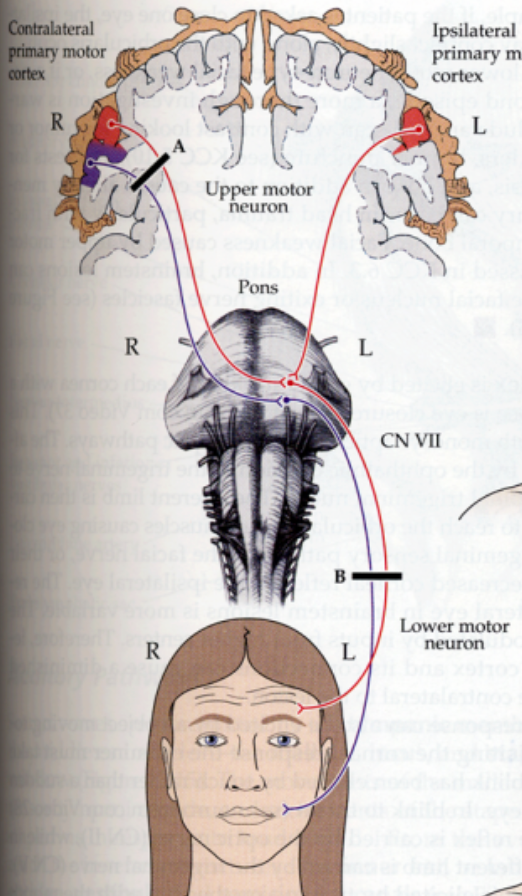
8
New cards
what is the ipsilateral innervation pathway?
innervation on same side of origin
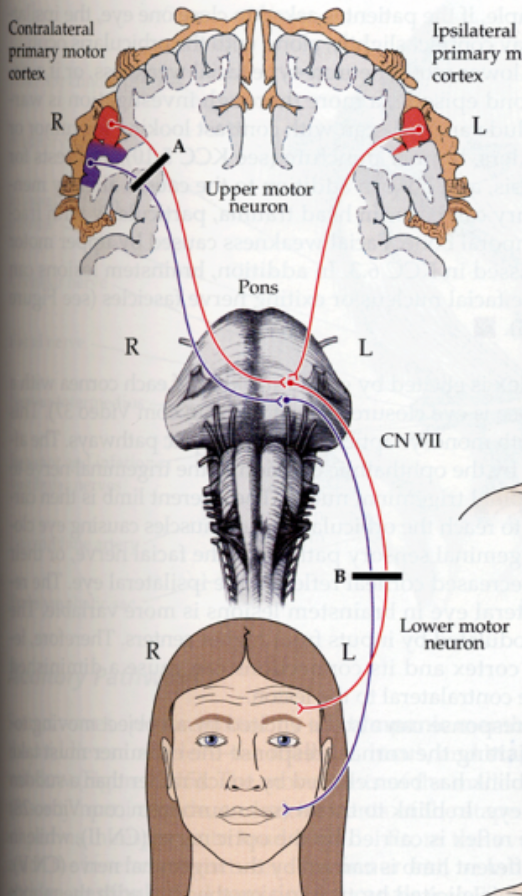
9
New cards
what is the bilateral innervation pathway?
innervation originates from both sides of brain
ipsilateral and contralateral
ipsilateral and contralateral
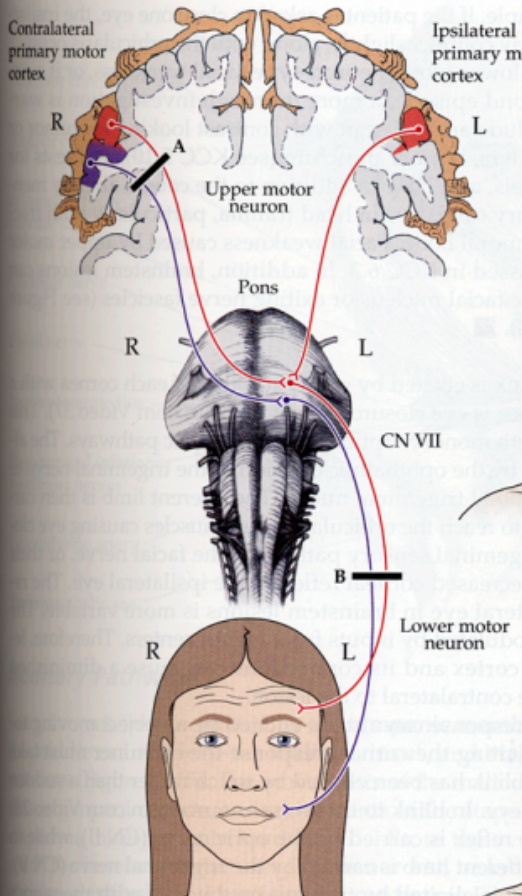
10
New cards
most nerves that control the lips, face and tongue are _____________ innervated.
bilaterally
11
New cards
what is the corona radiata?
giant projection fibers (axons) that connect cortex to internal capsule
neural highway
neural highway
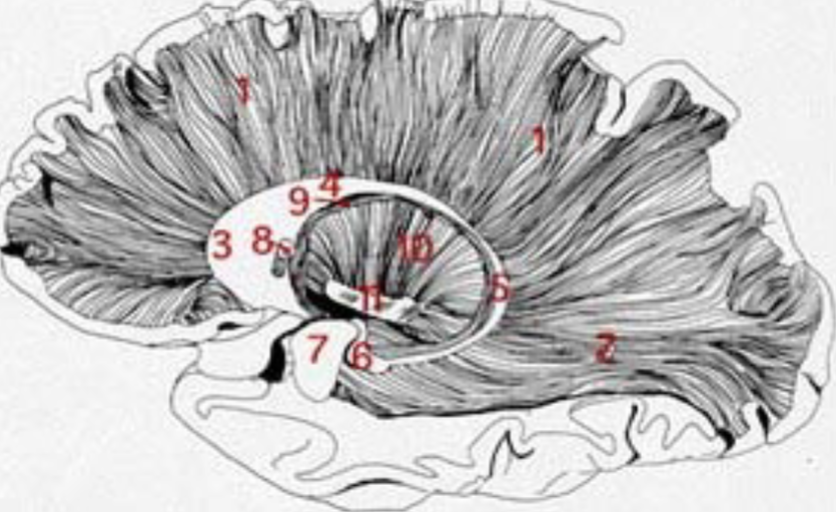
12
New cards
what is the internal capsule?
projection fibers- tract of axons from corona radiata that converges into tube
goes through striations of the basal ganglia
goes through striations of the basal ganglia

13
New cards
corticobulbar tract runs within which projection fiber structures?
internal capsule and corona radiata
14
New cards
define somatotopic organization
point-for-point correspondence of area of body to specific point on CNS
primary motor cortex’s map called homunculus
primary motor cortex’s map called homunculus
15
New cards
define upper motor neuron system
motor neurons in the CNS that initiate and modulate motor movement
intention!
intention!
16
New cards
what is the function of the direct activation pathway of the UMN system?
influences consciously controlled, skilled voluntary movement
(pyramidal)
begins in the motor area of the frontal lobe in the cortex
(pyramidal)
begins in the motor area of the frontal lobe in the cortex
17
New cards
what is the function of the indirect activation pathway of the UMN system?
mediates subconscious, automatic muscle activity (posture, muscle tone, supportive movement)
(extrapyramidal)
support DAP- keeps system ready to have voluntary movement
(extrapyramidal)
support DAP- keeps system ready to have voluntary movement
18
New cards
what tracts are associated with the DAP?
corticobulbar and corticospinal tracts
19
New cards
what tracts are associated with the IAP?
corticoreticular, corticorubral, reticulospinal tracts
20
New cards
where does the corticobulbar tract begin and end?
begins: cortex
ends: brainstem nuclei
ends: brainstem nuclei
21
New cards
where does the corticospinal tract begin and end?
begins: cortex
ends: spinal cord nuclei
ends: spinal cord nuclei
22
New cards
what is the function of the corticobulbar tract?
articulation, phonation, resonance
23
New cards
what is the function of the corticospinal tract?
respiration
24
New cards
where does the corticoreticular tract begin and end?
begins: cortex
ends: reticular formation
ends: reticular formation
25
New cards
where does the corticorubral begin and end?
begins: cortex
ends: red nucleus
ends: red nucleus
26
New cards
where does the reticulospinal tracts begin and end?
begins: reticular system
ends: spinal cord
ends: spinal cord
27
New cards
what is the function of the reticulospinal tract?
gross motor movements
28
New cards
what is the function of the corticorubral tract?
excite and inhibit muscles
29
New cards
what is the function of the corticoreticular tract?
life sustaining functions- blood pressure, respiration, muscle tone, posture, reflexes, relay station
30
New cards
what are the general unilateral symptoms of damage to DAP?
weakness, reduction of skilled motor movements, possible paralysis
31
New cards
what are the general bilateral symptoms of damage to DAP?
spastic dysarthria, bilateral weakness, complete loss of skilled movement
32
New cards
what are the general symptoms of damage to IAP?
deficits in posture, tone (spasticity), and reflexes (hyperreflexia)
33
New cards
what is the function of the reticular formation?
Life sustaining functions (blood pressure, respiration, sleep cycles), supports muscle tone, posture, reflexes, relay station
34
New cards
what is the final common pathway?
lower motor neuron system
35
New cards
what is the lower motor neuron system?
motor neurons that connect with upper motor neurons that activate skeletal/somatic muscles
starts in brainstem, ends in muscle
starts in brainstem, ends in muscle
36
New cards
what can damage to the lower motor neurons cause?
weakness, paralysis, paresis, atrophy, twitches, fibrillation, flaccidity
37
New cards
name the cranial nerves
I: olfactory
II: optic
III: oculomotor
IV: trochlear
V: trigeminal
VI: abducens
VII: facial
VIII: vestibular
IX: glossopharyngeal
X: vagus
XI: accessory
XII: hypoglossal
II: optic
III: oculomotor
IV: trochlear
V: trigeminal
VI: abducens
VII: facial
VIII: vestibular
IX: glossopharyngeal
X: vagus
XI: accessory
XII: hypoglossal
38
New cards
what number is the olfactory cranial nerve?
I
39
New cards
what number is the optic cranial nerve?
II
40
New cards
what number is the oculomotor cranial nerve?
III
41
New cards
what number is the trochlear cranial nerve?
IV
42
New cards
what number is the trigeminal cranial nerve?
V
43
New cards
what number is the abducens cranial nerve?
VI
44
New cards
what number is the facial cranial nerve?
VII
45
New cards
what number is the vestibular cranial nerve?
VIII
46
New cards
what number is the glossopharyngeal cranial nerve?
IX
47
New cards
what number is the vagus cranial nerve?
X
48
New cards
what number is the accessory cranial nerve?
XI
49
New cards
what number is the hypoglossal cranial nerve?
XII
50
New cards
what is the function of the olfactory (I) nerve?
smell
51
New cards
what is the function of the optic (II) nerve?
vision
52
New cards
what is the function of the oculomotor (III) nerve?
muscles for eyeball, pupil, upper lid
53
New cards
what is the function of the trochlear (IV) nerve?
superior oblique muscle of eye
54
New cards
what is the function of the trigeminal (V) nerve?
chewing and sensation to face, teeth, anterior tongue
55
New cards
what is the function of the abducens (VI) nerve?
abduction of the eye
56
New cards
what is the function of the facial (VII) nerve?
innervate facial muscles, taste, salivary glands
57
New cards
what is the function of the vestibular (VIII) nerve?
equilibrium and hearing
58
New cards
what is the function of the glossopharyngeal (IX) nerve?
taste, swallowing, elevation of pharynx and larynx, parotid salivary gland, sensation to posterior tongue, upper larynx
59
New cards
what is the function of the vagus (X) nerve?
taste, swallowing, elevation of palate, phonation, parasympathetic outflow to visceral organs
60
New cards
what is the function of the accessory (XI) nerve?
turning of head and shrugging of shoulders
61
New cards
what is the function of the hypoglossal (XII) nerve?
movement of tongue
62
New cards
what type of nuclei does the trigeminal (V) cranial nerve have?
3 sensory nuclei, 1 motor nuclei
63
New cards
where does the trigeminal (V) nerve receive sensory information from?
forehead, eyes, nose, lips, maxilla, teeth, cheeks, palate, maxillary sinus, anterior 2/3 of tongue, mandible, teeth, part of external ear
64
New cards
what does the trigeminal (V) nerve innervate?
muscles of mastication and tensor tympani muscle
65
New cards
what is the innervation pattern of the trigeminal (V) nerve?
bilateral innervation from UMN system
66
New cards
what happens when the unilateral LMN of the trigeminal (V) nerve is damaged?
lateral jaw movement issues, muscle atrophy, flaccidity or paralysis
deviation of jaw to side of lesion, inability to force jaw toward side opposite of lesion
deviation of jaw to side of lesion, inability to force jaw toward side opposite of lesion
67
New cards
what are the speech subsystems?
phonatory, resonance, articulatory and prosody
68
New cards
what happens when the unilateral and bilateral UMN of the trigeminal (V) nerve are damaged?
bilateral UMN: slow, weak and tight chewing and biting, restricted opening/closing of jaw, spasticity
unilateral UMN: same symptoms but usually mild or transitory
unilateral UMN: same symptoms but usually mild or transitory
69
New cards
what type of nuclei does the glossopharyngeal (IX) cranial nerve have?
1 sensory nucleus, 2 motor nuclei
70
New cards
where does the glossopharyngeal (IX) nerve receive sensory information from?
taste, ear skin, pharynx, posterior 1/3 of tongue
71
New cards
what does the glossopharyngeal (IX) nerve innervate?
parotid salivary gland, pharynx- stylopharyngeus
associated with gag reflex
associated with gag reflex
72
New cards
what is the innervation pattern of the glossopharyngeal (IX) nerve?
bilateral innervation from UMN system
73
New cards
what type of nuclei does the facial (VII) cranial nerve have?
1 sensory, 2 motor
74
New cards
where does the facial (VII) nerve receive sensory information from?
anterior 2/3 of tongue, glands
75
New cards
what does the facial (VII) nerve innervate?
facial expression, stapedius, glands, neck muscles
76
New cards
what is the innervation pattern of the facial (VII) nerve?
bilateral innervation to upper face, contralateral innervation to lower face
77
New cards
what happens when the unilateral LMN of the facial (VII) nerve are damaged?
weakness on entire side of face on side of lesion, ordinary sounds might seem loud
78
New cards
what happens when the unilateral UMN of the facial (VII) nerve are damaged?
mild or transitory to forehead, paralysis/paresis to lower facial muscles opposite side of lesion
79
New cards
what happens if there is UMN damage to the left facial nerve?
affects facial movement on lower right side, mildly affects all upper face movement
80
New cards
what type of nuclei does the vagus (X) cranial nerve have?
1 sensory, 2 motor
81
New cards
where does the vagus (X) nerve receive sensory information from?
tongue, external ear, thoracic and abdominal viscera, internal surfaces of laryngopharynx and larynx
82
New cards
what are the branches of the vagus (X) nerve?
pharyngeal
superior laryngeal → internal and external
recurrent laryngeal
superior laryngeal → internal and external
recurrent laryngeal
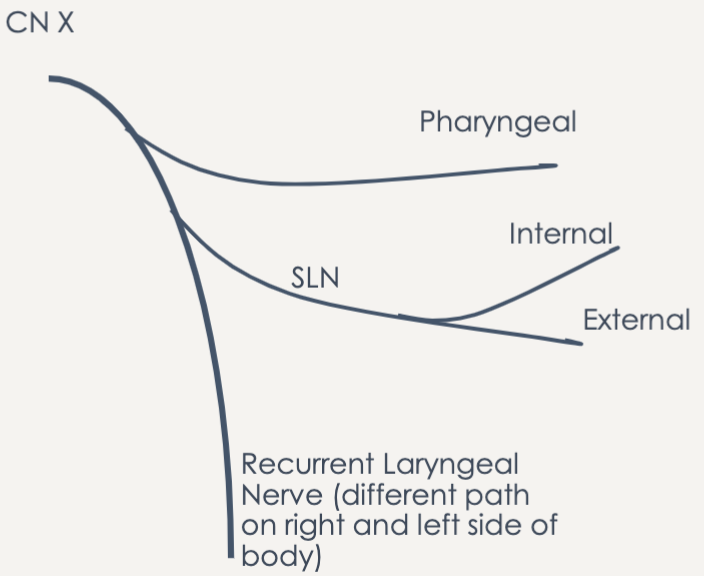
83
New cards
what does the vagus (X) nerve innervate?
pharyngeal branch: pharynx, soft palate
superior laryngeal nerve branch: inferior constrictor, cricothyroid, assist pharynx/palate
recurrent laryngeal nerve branch: intrinsic muscles of larynx
visceral: thoracic and abdominal area
superior laryngeal nerve branch: inferior constrictor, cricothyroid, assist pharynx/palate
recurrent laryngeal nerve branch: intrinsic muscles of larynx
visceral: thoracic and abdominal area
84
New cards
what is the innervation pattern of the vagus (X) nerve?
bilateral innervation from UMN system
85
New cards
what happens when the unilateral LMN of the vagus (X) nerve are damaged?
paralysis of ipsilateral vocal cord, perceptual voice characteristics are hoarse and breathy voice
86
New cards
what happens when the unilateral UMN of the vagus (X) nerve are damaged?
rough, harsh voice, rarely VF paralysis
87
New cards
what happens when the bilateral UMN of the vagus (X) nerve are damaged?
rough, hard, strained, tense voice, rarely VF paralysis
88
New cards
what type of nuclei does the hypoglossal (XII) cranial nerve have?
1 motor nucleus
89
New cards
what does the hypoglossal (XII) nerve innervate?
intrinsic and extrinsic muscles of tongue, genioglossus
90
New cards
what is the innervation pattern of the hypoglossal (XII) nerve?
contralateral innervation to genioglossus and bilateral innervation to tongue muscles
91
New cards
what happens when the unilateral LMN of the hypoglossal (XII) nerve are damaged?
ipsilateral side will look shrunken, tongue fasciculations, tongue deviates ipsilaterally to weaker side
92
New cards
what happens when the unilateral UMN of the hypoglossal (XII) nerve are damaged?
tongue deviates contralateral to side of lesion
93
New cards
what happens when there is any bilateral damage to the hypoglossal (XII) nerve?
difficulty protruding or moving tongue
94
New cards
what spinal nerves innervate the diaphragm?
phrenic nerve
95
New cards
what happens when the unilateral LMN of the spinal nerves are damaged?
not severe, if diaphragm weak, can cause- severe respiratory abnormalities
96
New cards
what happens when the unilateral UMN of the spinal nerves are damaged?
abnormal breathing patterns, severe respiratory abnormalities, death
97
New cards
what is the overall function of the control circuits?
contribute to control and programming of speech motor system beyond muscular execution
influence movement by interacting with cortex, not directly with nerves
influence movement by interacting with cortex, not directly with nerves
98
New cards
what is the function of basal ganglia direct pathway?
facilitates movement by pathway of inhibition
99
New cards
what is the function of the basal ganglia indirect pathway?
inhibits movement
100
New cards
what are the structures in the direct pathway of the basal ganglia control circuit?
cortex → striatum → globus pallidus internal → thalamus → cortex